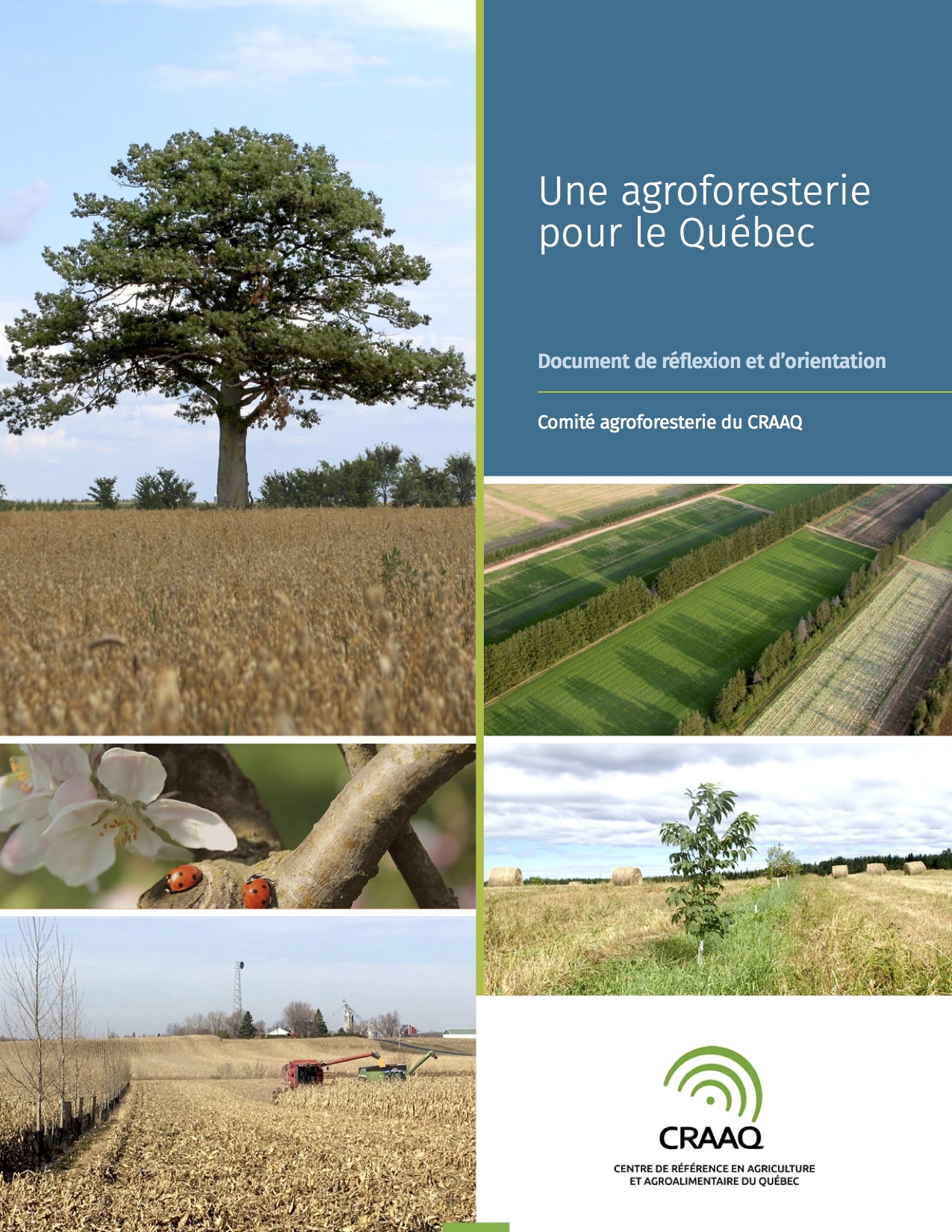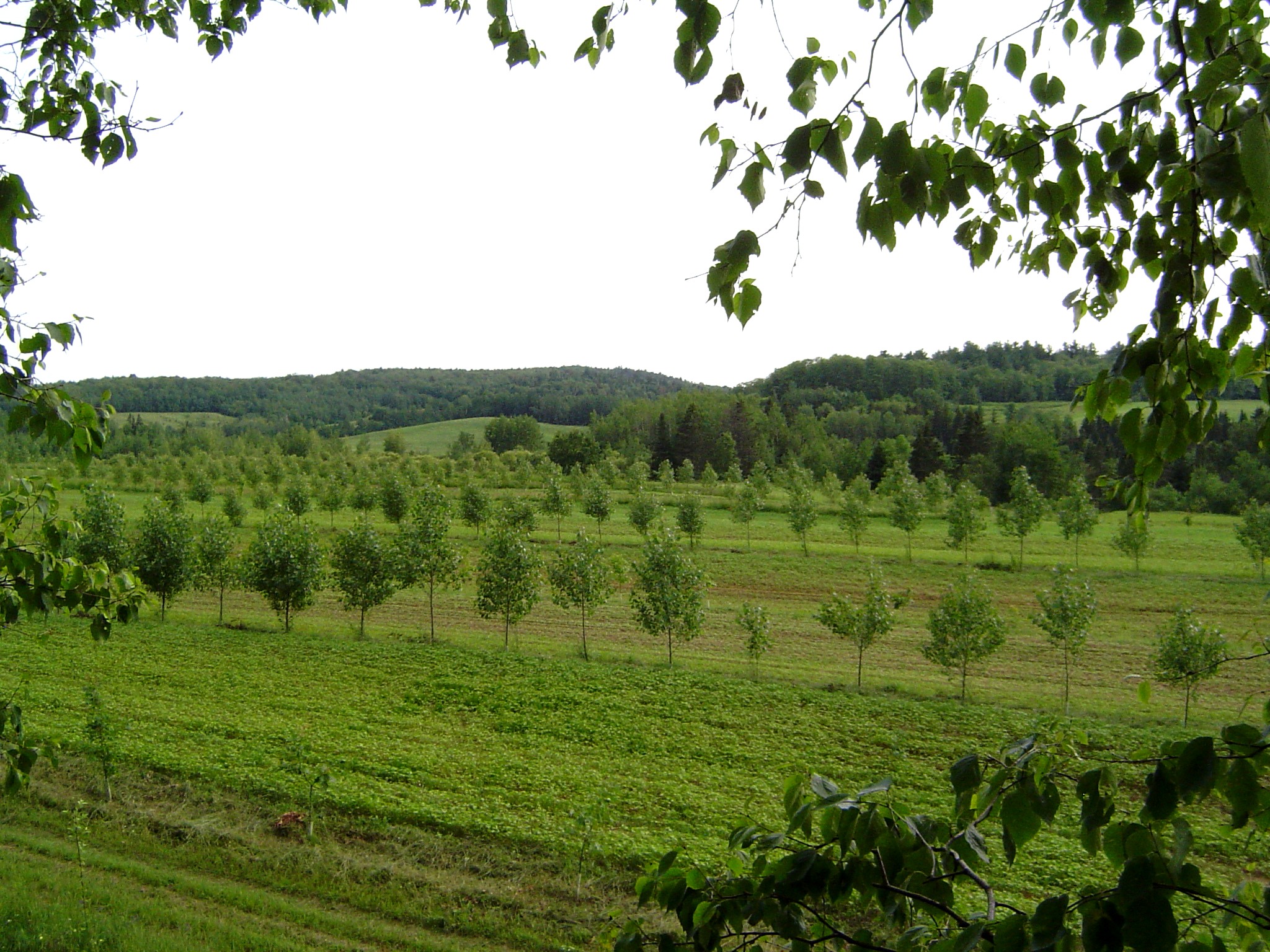A working group stemming from the Agroforestry Committee of the Quebec Reference Center for Agriculture and Agri-Food (CRAAQ), a network of experts aiming at sharing of information and knowledge transfer, was set up in order to develop a strategic document for promoting agroforestry practices in the province of Québec, Canada.
Entitled “Une agroforesterie pour le Québec: Document de réflexion et d’orientation” (Agroforestry for Quebec: An Orientation Document), the 73-page document (Figure 1) identifies the contribution of agroforestry to the resolution of six main agroecosystem issues in Quebec: soil health, biodiversity, water quality, climate change, rural landscape, and profitability of agricultural land exploitation. The current extent of agroforestry hedges (Figure 2) and intra-plot agroforestry systems (Figure 3) in the agricultural landscape is described, and an inventory of the resources available to farmers and landowners who wish to use agroforestry practices is prepared (availability and accessibility of practical knowledge, human resources, technical services, materials, education and training, research, networking, and institutional and policy support).
 Figure 1. Title page of the document on agroforestry development in the province of Quebec.
Figure 1. Title page of the document on agroforestry development in the province of Quebec.
An analysis of the current situation in view of the issues faced by the Quebec’s agroecosystem shows that agroforestry offers efficient solutions to most issues. Although agroforestry is highly beneficial for the society as a whole, its profitability is still uncertain at the farm level. Financial support is therefore essential to stimulate farmers and landowners to adopt agroforestry practices. Practical knowledge is sufficient to foresee agroforestry development, but applied research is needed to determine the best options, and cultivars adapted to the agroforestry context should be developed in order to optimize production. The analysis also emphasizes that only a small proportion of future farmers and their advisors are educated and trained in agroforestry. Moreover, while a number of ministries see agroforestry as a pertinent tool, there is no pooling of means nor common vision on agroforestry development.
 Figure 2. Windbreak in St-Roch-des-Aulnaies, Côte-du-Sud, Quebec. Photo: André Vézina.
Figure 2. Windbreak in St-Roch-des-Aulnaies, Côte-du-Sud, Quebec. Photo: André Vézina.
Based on the analysis, the working group made six recommendations: 1) recognition of the potential of agroforestry and its integration in policies and action plans by public authorities; 2) an increased technology transfer through the development of networks of agroforestry advisors and information tools, the creation of a network of demonstration sites, and the integration of agroforestry in the education of future farmers; 3) the provision of financial support to producers through a program specifically dedicated to agroforestry, applied to all agroforestry systems, and including all activities from plantation to maintenance of trees; 4) the creation of new knowledge through applied and fundamental research activities; 5) the development of plant material (trees and crops) specifically selected to perform well in agroforestry systems; and 6) the setting up of a provincial agroforestry networking group comprising of representatives from the main institutions related to agriculture, forestry, environment and territorial planning sectors.
 Figure 3. Intercropping system in St-Paulin, Mauricie, Quebec. Photo: David Rivest.
Figure 3. Intercropping system in St-Paulin, Mauricie, Quebec. Photo: David Rivest.
The next step for the Agroforestry Committee will be to ensure the dissemination of the document and its recommendations to farmers’ advisors and decision makers. The implementation of these recommendations should help the scaling-up of agroforestry systems in Quebec. In view of their contribution to the resolution of the challenges of the agroecosystem, such a scaling-up is highly advisable.
The document (in French - Anel B, Cogliastro A, Olivier A, Rivest D (2017) Une agroforesterie pour le Québec. Document de réflexion et d’orientation. Comité agroforesterie, Centre de référence en agriculture et agroalimentaire du Québec, Québec, Canada. 73 p.), as well as an executive summary (Résumé analytique), are now available at: https://www.craaq.qc.ca/Publications-du-CRAAQ/une-agroforesterie-pour-le-quebec-document-de-reflexion-et-d_orientation/p/PAGF0102-PDF
Alain Olivier, Faculty of Agriculture and Food Sciences, Laval University, Quebec City, Canada, G1V 0A6, This email address is being protected from spambots. You need JavaScript enabled to view it.

